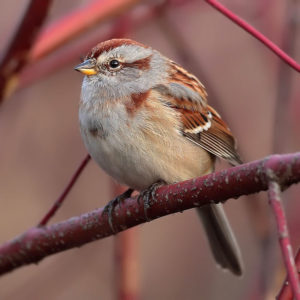Unlike many years, judging by the average daily temperatures, this winter was thrust upon us. It seems we missed out on those wonderful late fall days with temps in the mid-40’s when the woods are awash with colorful fallen leaves. They may return, but right now the world is prematurely snow-covered. A week ago, there was still a chipmunk under the bird feeder – I’m sure gathering seeds to be stored in its subterranean home for later snacking. Now it’s gone – perhaps sleeping on top of its larder. One wonders if such animals will feel the effects of the shortened gathering season later on.

One always wonders about the birds, too, and how they manage to stay warm. There are still some fall migrants around, like white-throated and song sparrows- hardy little birds which tolerate a lot of cold. And tree sparrows are yet to come. It turns out there are a number of things birds employ to stay warm in the winter.
First, birds are warmer than we are. Their body temperatures average 104 or 105 degrees F. Combined with their generally smaller size and greater relative surface area, they have to work hard to maintain those temperatures. Small birds like chickadees start shivering when the outside temperature is about 65 degrees. The movement of their muscles generates heat, and they will shiver the whole winter through.
We all know that birds have feathers – that’s one of the things that defines them. Feathers are amazing structures that give birds their streamlined shape, insulate them, repel water, and create displays to potential mates. How many feathers do birds have? Small songbirds have usually 1,500-3,000 feathers that are molted and replaced as they wear. The average bird has probably from 3,000 to 5,000 feathers. Large birds, like swans, have upwards of 25,000. Birds spend a lot of time tending and maintaining their feathers so that they function properly. They also molt and grow extra feathers in the fall.
Birds also have the ability to restrict blood flow to their legs and feet – preventing hypothermia. Even though they can do this, watching ducks in cold water in winter still makes me shiver. The scales on their legs also help to prevent heat loss. Many owls, on the other hand, have well-feathered legs to help them stay warm. Birds can fluff out their feathers, trapping air beneath them to provide extra insulation. On very cold days, this gives birds a puffy, swollen appearance.
Birds metabolize fat quickly. They store calories taken in from the sunflower seeds that we put out as fat. They can draw down their fat reserves quickly, also. If one catches birds for banding, one can sometimes see the change in fat reserves on a bird from day to day if the same bird is re-caught.
Some birds, including chickadees, go into a lower metabolic state at night called torpor. They aren’t actually hibernating – their metabolism drops just a bit, so they use less energy to make it through to morning.
Birds also adopt certain behaviors in winter- they find sunny places which are warmer and utilize dense vegetation to get out of the wind. (It can be significantly warmer under the boughs of a spruce tree, and some birds huddle together to share the warmth- chickadees are known to do that at night.)
The native trees and shrubs we planted help protect the songbirds in our yard during winter. The bird feeding area at Woodland Dunes is ringed with plants that shelter birds as they come in to feed. Offering high-quality foods like black sunflower, suet, and liquid water also makes things easier for birds in the winter. They are ingesting good nutrition and spending less energy than required to obtain water from frozen snow and ice. Birds have the tools to make it through the longest winter, and with a little help from us will generally do just fine.
The first tree sparrow showed up at the feeders today. Welcome back.
photo- American tree sparrow by Mdf from Wikipedia.
